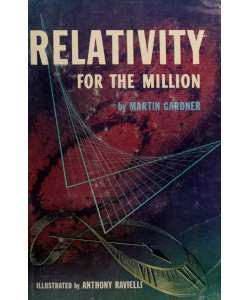Relativity for The Million

Author:
Martin Gardner
Publication:
1962 by Macmillan Publishing Company
Genre:
Non-fiction, Science
Pages:
182
Current state:
Basic information has been added for this book.
It is under consideration and will be updated when it is evaluated further.
Book Guide
Search for this book used on:
In a straightforward manner, with a minimum of mathematics, Martin Gardner explores the world of Einstein's relativity-a strange world where space by itself, and time by itself, are doomed to fade away into mere shadows, where our old ideas of motion, distance and time must be discarded, and where reality exists in four dimensions: three of space and one of time. Though much of this theory seems to contradict our "common sense," its basic concepts can be understood by any intelligent person, and are of such importance that they should be a part of everyone's education. This is the most up-to-date popular treatment of a theory that has not only revolutionized our view of the universe, but has also altered our lives and our society. Mr. Gardner examines the latest contemporary developments in the field of relativity-new experimental confirmations, new approaches to certain problems, and new models of the cosmos—as well as illuminating the history, concepts and practical conclusions of Einstein's theory.
The author makes many puzzling aspects of relativity accessible to the layman who wishes to keep up with modern science-the relation of the Special to the General Theory of Relativity; the Big Bang and Steady State theories of the origin of the universe; the absolutes in relativity; and the controversial Twin Paradox: how one twin may journey into space and return home younger than his brother.
The text is lavishly illustrated with dramatic two-color drawings that set the book apart from all others on this subject. Augmenting the text are a chronology of important dates in the history of relativity, a glossary and a bibliography.
From the dust jacket
To view an example page please sign in.
Find This Book
Search for this book used on:


